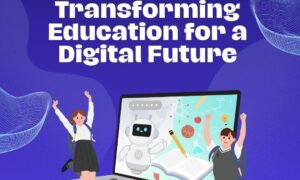In today’s rapidly evolving educational landscape, technology is revolutionizing how students learn and teachers teach. This transformation, however, requires a careful balance between innovation and ethical responsibility. SantoshKumar Pulijala delves into this intricate interplay in his research, providing a thought-provoking analysis of how advancements can align with educational values while safeguarding ethical principles. Kumar’s exploration offers a roadmap for navigating this dynamic field responsibly.
The Shift Towards Personalized Learning
Educational technology is advancing toward highly personalized learning experiences. Powered by artificial intelligence (AI) and machine learning, tools are now capable of analyzing individual student performance to craft customized educational paths. These systems allow educators to pinpoint areas where students struggle, enabling focused interventions that enhance overall learning efficiency and inclusivity.
However, the promise of personalization raises significant ethical concerns. Systems that rely on large datasets inevitably collect and process sensitive information about students. Ensuring data privacy and obtaining informed consent are critical for maintaining trust in these technologies. Robust privacy frameworks and secure data management practices must be implemented to ensure students’ rights are upheld without impeding innovation.
Fostering Collaborative Learning Environments
Collaborative technologies have transformed classroom dynamics by bridging geographical and social divides. Virtual classrooms, shared whiteboards, and online discussion platforms create spaces where students and educators can interact seamlessly, regardless of physical location. Such tools democratize education, bringing high-quality resources to underserved regions and fostering a sense of global community.
Despite these benefits, developers must ensure that collaborative platforms are equitable and accessible to diverse populations. Factors like language barriers, technological literacy, and internet access can hinder participation. Designing tools that accommodate varied needs and abilities is essential to prevent these innovations from reinforcing pre-existing educational inequities.
The Role of Gamification in Engagement
Gamification has emerged as a compelling strategy to make learning more engaging and interactive. By integrating elements like points, badges, leaderboards, and instant feedback into educational content, gamified systems turn lessons into immersive experiences. This approach motivates students to reach milestones and enhances retention by making learning enjoyable.
Nevertheless, gamification must be approached with caution. Overemphasis on competitive elements can create stress and feelings of exclusion for some students. To avoid these pitfalls, developers and educators should focus on designing gamified experiences that prioritize collaboration, encourage effort, and promote healthy competition, fostering a positive and inclusive learning environment.
Ethical AI in Educational Tools
Artificial intelligence is becoming a cornerstone of educational innovation, powering applications such as automated grading, adaptive learning systems, and curriculum design. However, the integration of AI also introduces ethical dilemmas surrounding transparency, accountability, and bias. Predictive algorithms, for instance, can inadvertently reflect societal biases if not carefully designed and monitored.
Creating explainable AI systems is a crucial step toward addressing these concerns. When educators and students can understand how AI-driven tools arrive at their recommendations or decisions, it fosters trust and facilitates broader acceptance. Ethical guidelines must be established to ensure AI applications are fair, unbiased, and accountable to all users, regardless of background.
Addressing Digital Divide Challenges
The digital divide remains a pressing challenge despite technological advancements. Students in underserved regions often lack reliable internet access or appropriate devices, limiting their ability to benefit from cutting-edge educational technologies. Bridging this gap requires intentional innovation aimed at inclusivity.
Solutions such as offline learning modules, low-bandwidth applications, and affordable devices can help extend the reach of educational technology to marginalized communities. By incorporating inclusive design principles and prioritizing accessibility, innovators can ensure that no student is left behind in the digital education revolution.
Towards a Responsible Future in Educational Technology
As the influence of educational technology continues to grow, its trajectory must be guided by ethical responsibility. This involves designing systems that protect privacy, embrace inclusivity, and promote transparency. Innovation must be driven by a commitment to creating equitable learning opportunities for all.
In conclusion, SantoshKumar Pulijala’s research highlights the critical balance between innovation and ethics, advocating for empowering technologies that respect learners’ rights. His work offers invaluable guidance for educators, technologists, and policymakers, providing a framework to shape a future where progress aligns with responsibility, addressing challenges and unlocking opportunities in evolving educational landscapes.



































